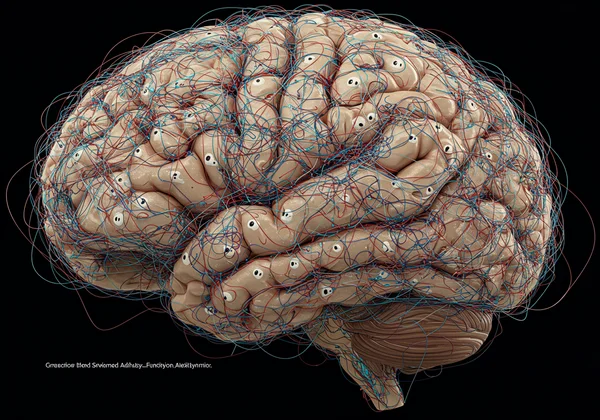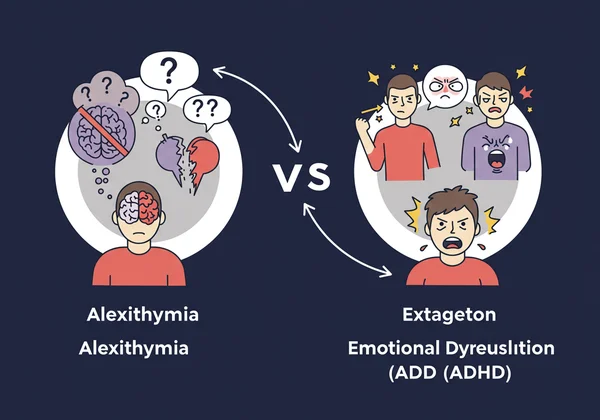알렉시티미아 테스트 & ADHD: 신경다양성 연관성 이해하기
감정을 이해하거나 표현하는 데 어려움을 겪는 ADHD 성인이신가요? 많은 신경다양성 개인들은 자신의 내면적 감정 세계에 대해 혼란스러워하며, 때로는 집중력 저하를 감정적 분리로 오해하기도 합니다. 당신은 종종 내 감정을 왜 이렇게 전달하는 데 서툴까? 라고 궁금해할 수 있습니다. 이 글은 알렉시티미아와 ADHD 사이의 간과되기 쉬운 연관성을 탐구하고, 감정 처리의 어려움과 실행 기능의 어려움을 구별하는 데 도움을 줄 것입니다. 이 연관성을 이해하는 것은 당신의 독특한 감정 경험에 대한 심오한 명확성을 제공할 수 있으며, 감정을 더 잘 탐색하는 데 중요한 첫걸음입니다.

알렉시티미아란 무엇이며 ADHD와 어떤 관련이 있을까요?
신경다양성의 복잡한 실타래를 푸는 것은 어렵게 느껴질 수 있지만, 이는 자신감을 북돋아 주는 과정입니다. ADHD 맥락에서 감정에 대해 이야기할 때, 대화는 종종 감정 조절의 어려움에 초점을 맞춥니다. 그러나 상당수의 사람들에게는 감정을 관리하는 것뿐만 아니라 애초에 감정을 식별하는 데 어려움이 있습니다. 바로 이 지점에서 알렉시티미아가 관련됩니다. 연구에 따르면 높은 공존율을 보이며, 내면 세계를 온전히 이해하기 위해 두 가지 개념을 모두 이해하는 것이 중요합니다.
알렉시티미아 정의: 단순히 "감정적으로 무감각한" 것 이상
알렉시티미아는 정신 건강 장애가 아니라 감정을 처리하고 이해하는 데 뚜렷한 어려움을 특징으로 하는 성격 특성입니다. 이 용어는 문자 그대로 "감정을 표현할 단어가 없음"을 의미합니다. 이는 단순히 감정적으로 무감각한 것보다 훨씬 더 미묘합니다. 알렉시티미아 특성이 높은 개인은 일반적으로 세 가지 핵심적인 어려움을 겪습니다.
- 감정 식별의 어려움: 심장이 뛰거나 배가 뭉치는 것과 같은 신체적 감각을 느끼지만, 이를 불안이나 흥분과 같은 특정 감정과 연결하는 데 어려움을 겪을 수 있습니다.
- 타인에게 감정을 설명하는 어려움: 감정을 어렴풋이 인식하더라도, 다른 사람에게 말로 표현하는 것은 불가능하게 느껴질 수 있습니다.
- 외부 지향적 사고방식: 내면의 생각, 환상, 감정 상태보다는 외부 사건과 세부 사항에 초점을 맞추는 경향.
이는 신체의 감정적 반응과 그 반응을 해석하고 이름을 붙이는 마음의 능력 사이의 단절입니다.
ADHD 및 감정 조절의 어려움: 명확히 구분되는 도전 과제
반면에 많은 성인 ADHD 환자들의 핵심 특징은 ADHD와 관련된 감정 조절의 어려움입니다. 이는 감정의 부재가 아니라 감정의 과잉입니다. ADHD에서의 감정 조절의 어려움은 조절하기 어려운 강렬하고 종종 압도적인 감정 반응으로 나타납니다. 갑작스러운 분노 폭발, 사소한 좌절에 대한 깊은 좌절감, 또는 강렬한 열정을 경험할 수 있습니다.
핵심적인 차이점은 ADHD와 관련된 감정 조절의 어려움이 있는 경우, 감정이 존재하고 강력하다는 것입니다. 때로는 너무 강력하게 느껴질 수 있습니다. 어려움은 감정의 강도와 그것이 유발하는 충동적인 반응을 관리하는 데 있습니다. 알렉시티미아의 경우, 주요 어려움은 감정이 발생하고 있다는 사실 자체를 인식하는 것입니다.
중첩되는 지형: 이 조건들이 교차하는 이유
그렇다면 알렉시티미아와 ADHD는 왜 그렇게 자주 함께 나타날까요? 과학계는 여전히 정확한 메커니즘을 탐구하고 있지만, 주요 이론은 실행 기능과 관련된 공유된 신경학적 뿌리를 지적합니다. 자기 인식, 충동 조절, 정보 처리를 담당하는 뇌 영역(ADHD에서 종종 영향을 받는 영역)은 감정 인식 및 조절에도 중요합니다.
뇌의 실행 기능이 집중력을 관리하고 작업을 우선순위화하는 데 어려움을 겪을 때, 미묘한 내면의 감정 신호를 포착하고 해석하는 데도 어려움을 겪을 수 있습니다. 이러한 중첩은 ADHD를 가진 많은 사람들이 강렬한 감정으로 어려움을 겪을 뿐만 아니라, 자신의 감정 상태를 이해하는 데 근본적인 어려움을 겪을 수 있음을 의미합니다. 이러한 어려움은 온라인 알렉시티미아 테스트를 통해 탐색을 시작할 수 있습니다.

증상 구분하기: ADHD인가, 아니면 알렉시티미아인가?
"내가 너무 많이 느끼는 건가, 아니면 전혀 느끼지 못하는 건가?" 이는 내면의 경험을 이해하려는 신경다양성 개인들이 흔히 하는 질문입니다. 사회적 어색함이나 관계의 어려움과 같이 겉으로 드러나는 징후는 비슷해 보일 수 있으므로, 내면의 작용을 살펴보는 것이 중요합니다. ADHD의 영향과 알렉시티미아 특성을 구별하는 것은 성장을 위한 올바른 전략을 찾는 데 핵심입니다.
실행 기능이 감정 표현에 영향을 미칠 때
ADHD의 실행 기능에 대한 핵심적인 어려움은 알렉시티미아를 직접적으로 모방할 수 있습니다. 예를 들어, 불량한 작업 기억은 과거 사건에 대해 어떻게 느꼈는지 기억하기 어렵게 만들어 "모르겠어요"라고 말하게 할 수 있습니다. 주의력 부족으로 인해 자기 성찰을 위해 내면으로 주의를 돌리기 어려울 수 있습니다.
더욱이 ADHD 증상을 관리하려는 끊임없는 노력은 소진을 유발하여 무관심이나 무감각으로 나타나는 감정적 번아웃으로 이어질 수 있습니다. 이는 감정을 식별하는 진정한 무능력이 아니라, 감정을 효과적으로 처리하기에는 너무 압도감을 느끼는 상태입니다.
신경다양성 개인의 알렉시티미아 핵심 특성 인식하기
진정한 신경다양성 알렉시티미아 특성을 식별하려면 ADHD 증상을 넘어서 봐야 합니다. 핵심 질문은 다음과 같습니다. 당신이 차분하고 잠시 숙고할 시간이 있을 때, 무엇을 느끼고 있는지 식별할 수 있습니까?
ADHD를 가진 사람은 "어제 너무 화가 나서 제대로 생각할 수 없었어요"라고 말할 수 있습니다. 그들은 감정이 분노였다는 것을 알지만, 문제는 그 강도였습니다. 알렉시티미아를 가진 사람은 "어제는 그냥 안 좋은 날이었어요. 몸이 긴장된 것 같았지만 왜 그런지 모르겠어요"라고 말할 수 있습니다. 감정 자체는 미스터리입니다. 이 미묘하지만 중요한 차이점은 알렉시티미아 테스트가 명확히 하는 데 도움이 될 수 있으며, 알렉시티미아 설문지를 작성하는 것은 훌륭한 출발점입니다.
실제 시나리오: 감정적 혼란 풀기
두 가지 짧고 익명적인 예를 통해 차이점을 설명해 보겠습니다.
- 시나리오 1 (ADHD와 관련된 감정 조절의 어려움): 크리스는 직장에서 사소한 비판적 피드백을 받습니다. 그는 즉시 뜨거운 수치심과 분노를 느낍니다. 그는 폭발하고 싶지만 그래서는 안 된다는 것을 알고, 물러나서 나머지 하루를 대화를 되새기며 보냅니다. 그의 강렬한 감정 때문에 집중하는 것이 불가능합니다. 그는 자신이 화나고 상처받았다는 것을 알지만, 감정의 강도를 낮추기 어려운 것 같습니다.
- 시나리오 2 (알렉시티미아): 조던의 파트너가 저녁 내내 왜 그렇게 조용하고 멀리 떨어져 있었는지 묻습니다. 조던은 잠시 멈춰 서서 생각합니다. 그들은 가슴에 불편한 압박감과 막연한 불안감을 느끼지만, 그것에 대한 감정의 이름은 없습니다. 그들은 솔직하게 "모르겠어요"라고 대답합니다. "그냥 피곤한 것 같아요." 신체적 감각은 있지만, 감정에 대한 정보는 없습니다.
ADHD와 함께 알렉시티미아를 다루는 전략
자신에게서 이러한 패턴을 인식하는 것이 첫걸음입니다. 다음은 ADHD의 감정적 강렬함과 알렉시티미아의 감정적 모호함이라는 두 가지를 모두 다루는 전략 도구 상자를 구축하는 것입니다. 이것은 자신을 '고치는' 것이 아니라, 자신의 내면 세계와 더 나은 관계를 구축하는 것입니다.
감정 인식 구축: 자신을 탐구하는 사람들을 위한 실용적인 기술
감정 이해력을 개발하는 것은 배울 수 있는 기술입니다. 특히 실행 기능이 어려운 경우 인내심과 꾸준한 연습이 필요합니다.
- 감정 바퀴 사용: 강한 신체적 감각을 느낄 때, 휴대폰에서 감정 바퀴를 엽니다. 단어들을 살펴보고 조금이라도 공감되는 것이 있는지 확인합니다. 이것은 당신에게 부족할 수 있는 감정을 표현할 단어를 찾는 데 도움을 줍니다.
- 바디 스캔 연습: 3분 타이머를 설정합니다. 눈을 감고 머리부터 발끝까지 몸을 정신적으로 스캔합니다. 판단 없이 어떤 긴장, 따뜻함, 떨림이 있는지 알아차립니다. 목표는 단순히 마음을 몸의 신호와 연결하는 것입니다.
- "감각 일기" 시작: 감정 이름을 붙이려고 하는 대신, 하루 종일 경험하는 신체적 감각을 단순히 적어봅니다. "회의 중에 가슴이 답답함" 또는 "고양이가 무릎에 앉았을 때 따뜻한 느낌." 시간이 지남에 따라 패턴을 보기 시작할 수 있습니다.

관계 및 사회적 환경에서 의사소통 개선하기
감정의 이름을 붙일 수 없을 때 자신의 필요를 전달하는 것은 큰 장애물입니다. 가지고 있지 않은 감정적인 명칭을 제공해야 한다는 압박감을 느끼는 대신, 더 사실적이고 투명한 언어를 사용해 보세요.
- "지금 제가 매우 긴장하고 있다는 것을 알아차렸어요. 잠시 생각할 시간이 필요해요."
- "특정 감정을 식별할 수는 없지만, 제 몸이 뭔가 잘못되었다고 말하고 있어요."
- "조금만 기다려주시면 감사하겠습니다. 뭔가 느끼고 있지만, 아직 그것을 표현할 단어가 없어요."
이러한 접근 방식은 정직하며 다른 사람들이 당신을 지원할 명확한 방법을 제공합니다. 이러한 특성을 인식하는 것은 더 나은 의사소통을 향한 가치 있는 첫걸음입니다.
전문가의 도움을 찾아야 할 때: 더 깊은 이해로 가는 길
이러한 자가 치유 전략이 강력하지만, ADHD와 알렉시티미아를 모두 이해하는 치료사와 함께 작업하는 것은 긍정적인 변화를 가져올 수 있습니다. 전문가는 맞춤형 기술과 감정의 세계를 탐색할 안전한 공간을 제공할 수 있습니다. 온라인 테스트는 자기 탐색 및 정보를 위한 도구일 뿐, 전문적인 진단을 대체할 수는 없다는 점을 기억하세요.
다음 단계: 감정의 세계를 받아들이기
알렉시티미아와 ADHD 사이의 복잡한 관계를 이해하는 것은 또 다른 진단명을 붙이는 것이 아닙니다. 그것은 당신 자신의 마음에 대한 더 정확하고, 자비롭고, 유용한 지도를 얻는 것입니다. 그것은 당신이 '정상적인 방식'으로 느끼지 못한다고 자신을 판단하는 것을 멈추고, 당신의 독특한 신경학적 특성에 맞는 전략을 사용하도록 힘을 실어줍니다. 이러한 명확성은 자기 인식을 향상시키고, 관계를 강화하며, 전반적인 행복을 증진시킬 수 있습니다.
당신의 감정 처리 방식을 더 명확하게 이해할 준비가 되셨습니까? 천 리 길도 한 걸음부터입니다. 오늘 저희의 무료 과학 기반 알렉시티미아 테스트를 받아 즉시 결과를 확인하고, 실행 가능한 통찰력을 담은 맞춤형 AI 보고서 옵션을 이용해 보세요.

자주 묻는 질문
알렉시티미아와 ADHD를 동시에 가질 수 있나요?
네, 물론입니다. 연구에 따르면 이 둘 사이에는 상당한 중복이 있습니다. ADHD를 가지고 있으면 알렉시티미아 특성을 가질 가능성이 높아질 수 있는데, 이는 실행 기능과 뇌의 감정 처리 영역에서 공유되는 어려움 때문일 가능성이 높습니다. 테스트는 당신이 스펙트럼의 어느 부분에 속하는지 확인하고 이해를 위한 여정을 시작하는 데 도움을 줄 수 있습니다.
ADHD에서의 감정 조절의 어려움은 알렉시티미아와 어떻게 다른가요?
ADHD에서의 감정 조절의 어려움은 감정을 매우 강렬하게 느끼고 그 강도와 그로 인한 충동을 관리하는 데 어려움을 겪는 것을 포함합니다. 알렉시티미아는 애초에 감정을 식별하고 설명하는 데 어려움이 있습니다. 전자는 볼륨 조절에 관한 것이고, 후자는 신호 감지에 관한 것입니다.
알렉시티미아는 ADHD를 가진 사람들에게 더 흔한가요?
현재 연구에 따르면 그렇습니다. 알렉시티미아는 일반 인구에서도 발생할 수 있지만, ADHD 및 자폐 스펙트럼 장애(ASD)와 같은 신경발달 질환을 가진 개인들 사이에서 그 유병률이 현저히 높습니다.
알렉시티미아와 ADHD가 있다면 치료가 도움이 될까요?
네, 치료는 매우 효과적일 수 있습니다. 신경다양성에 대해 잘 아는 치료사는 ADHD 증상 관리와 감정 이해 능력을 기르는 데 필요한 전략을 모두 도와줄 수 있습니다. 인지 행동 치료(CBT) 및 마음챙김 기반 접근법과 같은 치료법은 이러한 공존 특성에 맞게 종종 적용됩니다.
ADHD가 있는데 감정에 대해 이야기할 때 왜 얼어붙을까요?
이러한 '얼어붙음'은 여러 요인의 결과일 수 있습니다. 진정으로 무엇을 말해야 할지 모르는 알렉시티미아 특성일 수도 있습니다. 또한 실행 기능 과부하(뇌가 압도되어 멈춤) 또는 거부 민감성 불쾌감(RSD)과 같은 ADHD 관련 문제일 수도 있으며, 이때 잘못된 말을 할까 봐 두려워 마비되는 것입니다.